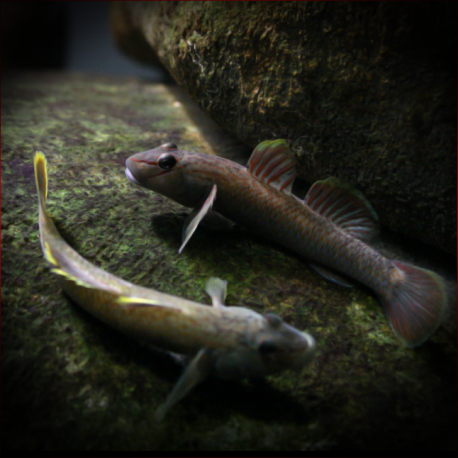More info
Datasheet
| Minimum Tank Size | 72 litres / 19.02 US gallons |
| Maximum Size | 8.0cm / 3.15inches |
| Temperature | 18°C / 64.40°F - 28°C / 82.40°F |
| Hardness | 5.04dgH / 90ppm - 12.05dgH / 215ppm |
| pH | 6.0-8.0 |
General Description:
The Rhinogobius Candidianus, a member of the Gobiidae family, is a robust species known for its aggressive tendencies, typically observed in community settings. It thrives when paired with peaceful, pelagic species like Tanichthys or Danio varieties, while larger fishes and freshwater shrimp are less suitable tankmates. Male Rhinogobius Candidianus are territorial to an extent, but serious damage is unlikely when the tank provides sufficient cover. It is recommended to keep at least two males and several females to maintain their active behavior.
Aquarium Setup:
To recreate the natural habitat of the Rhinogobius Candidianus, a tank designed to mimic a flowing stream is ideal. The setup should include variably-sized rocks, sand, fine gravel, and water-worn boulders, along with driftwood branches, terracotta pipes, and plant pots to create hiding spots. While most aquatic plants struggle in such an environment, hardy varieties like Microsorum, Bolbitis, or Anubias species can be attached to decor. Regular 30-50% water changes and proper filtration to maintain spotless water quality are essential.
Behaviour:
The Rhinogobius Candidianus can exhibit aggression but can coexist in community tanks with careful selection of tankmates. They actively require the presence of conspecifics, preferring to be housed in groups of males and females. It is territorial, especially among males, and may become listless or inactive if not provided with appropriate social settings.
Feeding and Diet:
Being opportunistic carnivores, Rhinogobius Candidianus primarily feed on small invertebrates and crustaceans in their natural habitat. In aquariums, they should be offered small live or frozen foods like chironomid larvae, Artemia, Daphnia, and Mysis. While they may eventually accept dried foods, a diet rich in live or frozen foods is preferable for their overall health.
Reproduction & Dimorphism:
During reproduction, eggs of Rhinogobius Candidianus are deposited on the ceiling of caves or crevices and guarded by the male until hatching. Adult males develop an extended primary ray in the first dorsal fin and possess elongated jaws compared to females. In gravid females, the eggs are visible as a bluish mass in the abdomen. Spawning occurs secretly within caves, and brood size typically ranges from 20-100 eggs per clutch.
Habitat and Distribution:
The Rhinogobius Candidianus is widely distributed throughout northern and western Taiwan in rivers and smaller tributaries. It inhabits seasonally variable habitats with substrates consisting of gravel, rocks, boulders, and exposed bedrock. These fish thrive in subtropical monsoon climates characterized by high temperatures, humidity, and heavy rainfall, with water flow rates increasing during the monsoon season.

